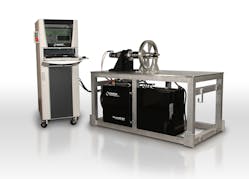Components and materials for deep-space use, such as in satellites and spacecraft, have a special set of requirements to ensure reliable long-term operation in a vacuum. Satellite suppliers such as Lockheed Martin perform almost continuous testing of components and materials in vacuum chambers to better understand the effects of vacuum conditions, as well as wide temperature extremes.
Such testing often involves equipment not normally found in traditional electronic test labs, including the AC motoring dynamometers employed in the Lockheed Martin Space System’s Materials Technologies Laboratory (see photo). Supplied by Sakor Technologies, Inc., the AccuDyne dynamometers have been a fixture in the laboratory since 2012, notably for testing the R-Series Geostationary Operational Environmental Satellites (GOES-R) for the National Oceanic and Atmospheric Administration (NOAA).
Dynamometers are used for precision motor control when testing movable systems in satellites.
The two most recent dynamometers supplied by Sakor to Lockheed Martin feature a number of updates and enhancements over the original systems, with the capability to directly control motors and drives with or without the MIL-STD/1553 avionics bus. The dynamometer systems are designed for use with magneto-fluidic couplings. As a result, they can test products within a thermo-vacuum chamber while the dynamometer remains outside the chamber.
The dynamometers can be used as independent test systems, or in networked configurations with as many as four dynamometers operating for comparison of motors and drives under different operating conditions, or different components under similar operating conditions. The two latest systems are capable of a wide range of torques and speeds, including high-torque rotation as slow as 3 × 10-6 rpm, which equates to one full rotation every 231.5 days—the type of motor controlled needed for satellite applications.


